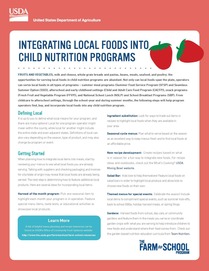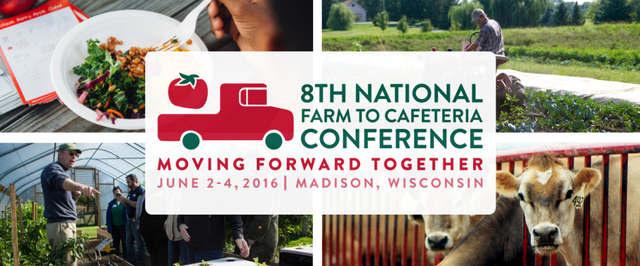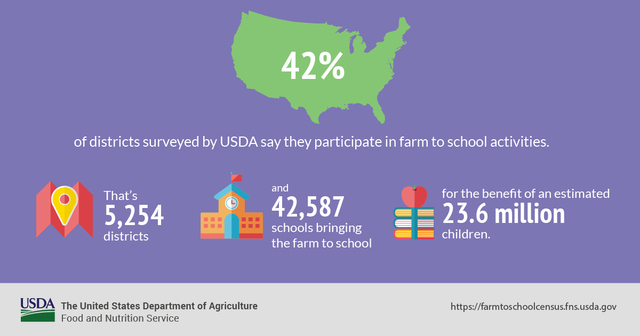
Is your district One in a Melon?
Now
through April 15, USDA is running a contest for school districts to win a “One in a
Melon” award. Parents, teachers, community stakeholders and even students can
visit the Census website and nominate their favorite farm to school program to receive
this award. One school district from each state with the most nominations will
win. “One in a Melon” award winners will be announced before school lets out
this year.

 New Fact Sheet: Integrating local foods in ALL child nutrition programs
The opportunities for serving local foods in child nutrition programs
are abundant. Not only can local foods span the plate, operators can
serve local foods in all types of programs. From childcare to
afterschool settings, through the school-year and during summer months,
the steps outlined in this new fact sheet will help program operators find, buy, and incorporate local foods into any child nutrition program.
|

Upcoming Webinars
There's something for everyone in the coming weeks and months. Mark your calendars, and don't miss out on these great farm to school resources!
 Keeping the
Tradition (traditional foods that is!) Alive: Community Food Systems in Native
Communities
Starting this Thursday, USDA’s Office of Community Food Systems will
host a four-part webinar series focused on integrating farm to school
strategies in native communities. Each webinar will feature a guest speaker who
will share tips, stories and best practices for keeping local food traditions
alive in child nutrition programs that serve tribal populations.
What Does Farm to
School Look Like in Native American Communities? April 6, 3:00 PM EDT
The first in a series of four webinars, this webinar will
offer an overview of what community food systems may look like in tribal
communities. Farm to school efforts help children make informed food choices
and can support local agricultural producers. Pam Kingfisher will provide an overview about the work the National
Farm to School Network has been doing in native communities and Mark Sorensen, co-founder of the
Star School located in Arizona, will share tips, best practices, and innovative
ideas for starting a farm to school program.
|

Incorporating
Traditional Foods in Child Nutrition Program Menus: April 20, 3:00 PM EDT
Where do traditional foods fit?! In this webinar we'll
discuss best practices for incorporating traditional foods into child nutrition
programs. Alaska's Department
of Natural Resources will share how Alaskan communities are integrating local
foods and Jenny Montague, a nutritionist with FNS, will share some real life
examples of districts that are substituting local foods into CNP meals.

Engaging Students: May
4, 3:00 PM EDT
Incorporating nutrition education related to traditional
food items into cultural activities such as ceremonial songs and storytelling
helps students to identify food as part of Native American heritage. This
webinar will help you plan for farm to school educational efforts which engage
students throughout the year. Gloria Begay, a Navajo Educator, will highlight
school garden efforts and local foods activities in summer meals.

Partnering for Success in Tribal Communities: May 20,
3:00 PM EDT
Everything is better together, right?! In
the final webinar in a series of four, we’ll hear from two practitioners who
illustrate that partnerships make the difference in keeping food traditions
alive in child nutrition programs. This webinar will identify strategies to
engage local producers and community leaders in your farm to school efforts.

Planning for Farm to School Success
Curriculum Integration:
April 7, 2:00 PM EDT
Experiential education is an important component of successful farm to school
programs. This webinar will help you plan for your farm to school educational
efforts and brainstorm food, agriculture, and nutrition-related educational
activities with which you can engage students.

Program Sustainability: April 28, 2:00 PM EDT
Your
farm to school project is blooming! But what will happen if funding
levels decrease or community interest lags? With this webinar, plan
ahead for these potential scenarios and learn about program
sustainability best practices.


Chop! Chop! Culinary Skills
for Locally-Grown Produce in School Meals
Funded through a Wisconsin Specialty Crop Block
Grant and a USDA Team Nutrition grant, the Chop! Chop! Wisconsin-Grown Produce
Culinary Videos focus on root vegetables, dark leafy greens, brassicas,
tomatoes and peppers, winter squash, and whole wheat flour and grains. Each
training covers culinary preparation techniques and offers ideas for
incorporating local produce into school salad bars and menus. In addition, each
of the six videos feature discussions with Wisconsin farmers and their school
partners on the farm and in the school kitchen. These training videos are a
joint project of CESA Purchasing Nutrition Program,
the Center for
Integrated Agricultural Systems and Team Nutrition
at the Wisconsin Department of Public Instruction.
|

 National Farm to Cafeteria Conference Coming this June
Don’t miss the 8th National Farm to Cafeteria Conference in Madison, Wis., June 2-4, 2016. This event is the only national gathering of stakeholders from across the farm to cafeteria movement, making it a crucial leadership development opportunity to advance community health, build economic opportunities for farmers and producers, and ensure long-term sustainability for local food efforts nationwide.


We’ve talked quite a bit in the past
about the major benefits we’re seeing in schools and districts that
have established a farm to school program. Their efforts are giving
students a deep understanding and appreciation for where their food comes from and drastically shifting kids’ opinions of fruits and veggies.
The final results of the USDA Farm to School Census 2015 shed light on another huge benefit of farm to school – we’re talking $789 million huge.
That’s the total amount schools report investing in their communities
in school year 2013 – 2014 by purchasing local food from farmers,
ranchers, fisherman, food processors, and manufacturers. This
represents a 105 percent increase over school year 2011 – 2012,
when the first USDA Farm to School Census was conducted. In addition,
nearly half (47 percent) of districts engaged in farm to school report
that they plan to purchase more local foods in the coming years.

|









